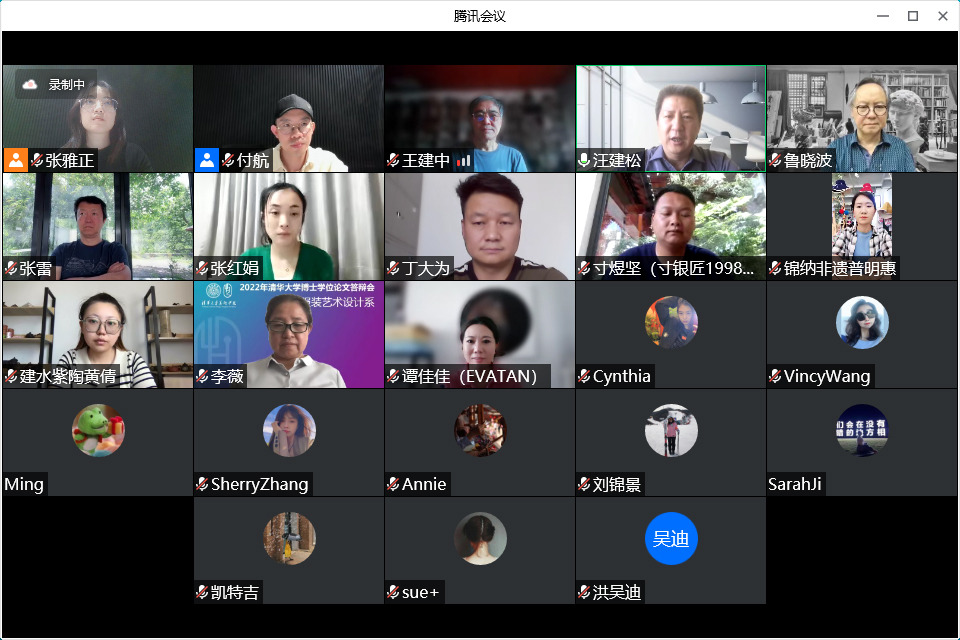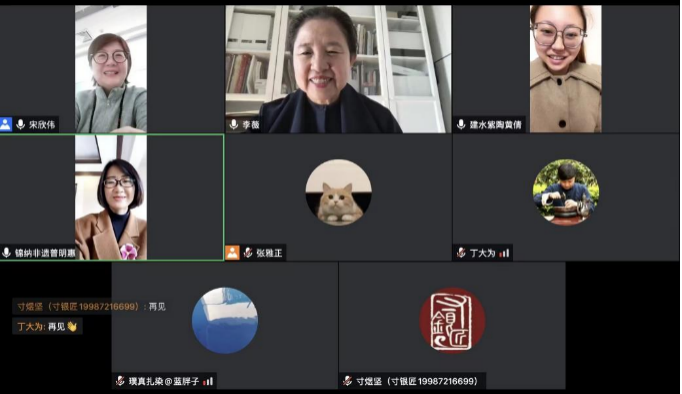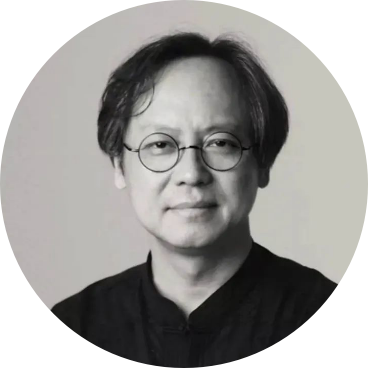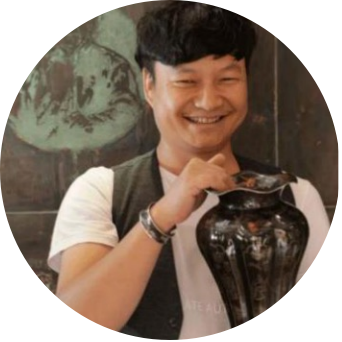Instructor Meeting of the 2021-2022 Tsinghua BMW "Exploration and Practice of Innovation Mode for ICH Safeguarding" Project Held Online
On the afternoon of May 27, 2022, the Instructor Meeting of the 2021-2022 Tsinghua BMW "Exploration and Practice of Innovation Mode for ICH Safeguarding" Project was successfully held in the form of an online meeting. The project is jointly organized by the Academy of Arts & Design, Tsinghua University ("AADTHU"), BMW China Automotive Trading Ltd., BMW Brilliance Automotive Ltd., and Tsinghua (Qingdao) Academy of Arts and Science Innovation Research ("the Academy").
Based on the intangible cultural heritage and the inheritors selected by the visiting activities of the "BMW China Culture Journey" project, the project team is formed by Tsinghua University's expert instructors and ICH inheritors to explore the innovative paths and extension models of ICH inheritance, protection and development through five representative ICH projects for the ICHs in Yunnan Province, including the craft of silver-inlaid black copper, Heqing silverware, Jianshui Purple Pottery, Bai tie-dyeing, and Yi embroidery.
The meeting was hosted by Wang Jiansong, vice president of Tsinghua (Qingdao) Academy of Arts and Science Innovation Research. President Lu Xiaobo, professor Wang Jianzhong, professor Li Wei, professor Zhang Lei, associate professor Zhang Hongjuan, assistant researcher Tan Jiajia, and postdoctoral fellow Liu Jinjing of the Academy of Arts & Design, Tsinghua University attended the online meeting as representatives of the instructors and briefly introduced their research fields. The five corresponding ICH inheritors, Ding Dawei, Huang Qian, Duan Yuan, Cun Yujian and Pu Minghui, also introduced their biographies, ICH skills and works. Li Dan, Manager of Public Relations and Corporate Social Responsibility Department of BMW Brilliance Automotive Ltd., attended the online meeting as a guest.
The meeting started with a video review of the results of the previous incubation programs for ICH inheritors and an outlook on the new phase of the project. Lu Xiaobo, president of the Academy of Arts & Design, Tsinghua University ("AADTHU"), said at the meeting that AADTHU and BMW have established the Tsinghua BMW "Innovation Center for ICH Safeguarding Practice Project" based on the concept of inheriting China's excellent traditional culture and the common social responsibility and feelings. He hoped that through exchanges and cooperation with the ICH inheritors, we could help intangible cultural heritage enter modern life and, at the same time, enhance our understanding of traditional culture, which in turn would promote scientific research progress. With the joining of the Tsinghua (Qingdao) Academy of Arts and Science Innovation Research, we will industrialize intangible cultural heritage achievements and form a strong brand effect by taking the cultivation mode of AADTHU as the foundation and combining the industrial advantages, brand incubation and innovation ability of the Academy, to let the ICH socialized innovation achievements come into the public view indeed.
Wang Jiansong, vice president of Tsinghua (Qingdao) Academy of Arts and Science Innovation Research, also expressed his expectation for the results of this project. He said that the achievements created by the instructors and inheritors jointly through the ICH cooperation platform of AADTHU and BMW would be incubated through the assistance of Tsinghua (Qingdao) Academy of Arts and Science Innovation Research in the future, and form a social transformation finally.

Instructor Meeting of the 2021-2022 Tsinghua BMW "Exploration and Practice of Innovation Mode for ICH Safeguarding" Project
From December 18 to December 29, 2021, a series of excellent lectures were held by the Tsinghua BMW "Exploration and Practice of Innovation Mode for ICH Safeguarding" Project. The instructors participating in the cooperation project and the specially invited lecture experts who care about and support the innovation and development of ICH skills were invited by the lecture to focus on improving the artistic aesthetics and cultivation of ICH inheritors. In the last lecture, the five inheritors also exchanged their experiences with the instructors.

Series of excellent lectures of Tsinghua BMW "Exploration and Practice of Innovation Mode for ICH Safeguarding" Project
The 2021-2022 Tsinghua BMW "Exploration and Practice of Innovation Mode for ICH Safeguarding" Project opened a new chapter through this online meeting with the inheritors. On the basis of continuing the previous model of Tsinghua BMW ICH Safeguarding Innovation Base, it will further expand new models for cultural inheritance and product transformation, and look forward to promotion and development of the ICH innovation model through innovation training, practice, and product achievements. We wish the 2021-2022 Tsinghua BMW ICH Safeguarding Innovation Base Project to be successfully held, being a significant facilitator for China's ICH entering modern life and promoting the marketization and branding of China's ICH industry.
Introduction to instructors and inheritors of the ICH project
Project team of the craft of silver-inlaid black copper

Instructor: Lu Xiaobo
President of the Academy of Arts & Design, Tsinghua University
Vice chairman of the China Artists Association
Professor of the Academy of Arts & Design, Tsinghua University
Doctoral instructor

Instructor: Tan Jiajia
Assistant researcher of the Academy of Arts & Design, Tsinghua University
Instructor: Liu Jinjing
Postdoctoral fellow of the Academy of Arts & Design, Tsinghua University

Inheritor: Ding Dawei
Representative inheritor of intangible cultural heritage project at the municipal level
The seventh-generation inheritor of the "craft of silver-inlaid black copper"
As a unique pure metal handicraft in Yunnan, the "craft of silver-inlaid black copper" was first created in Shiping County of Yunnan during the Yongzheng period of the Qing Dynasty, with a history of nearly 300 years. It takes black copper as the body. First, various patterns are carved on the body. Then, pure silver (or gold) is melted and poured into the marks of the pattern. High temperature is used to integrate silver (or gold) and black copper. After cooling, molding, polishing, copper blackening and other technical treatments, the bottom copper will naturally turn black, and the silver (or gold) pattern will appear, showing a clear black and white (or black and yellow) technical effect. The finished products of this craft are antique, elegant and chic. Most of them are silver plated; hence the name "silver plated copper".
Representative works of intangible cultural heritage inheritors
[Far from the Mortal World] Teakettle
Project team of Heqing silverware
Instructor: Ma Sai
Secretary of the Party Committee of the Academy of Arts & Design, Tsinghua University
Professor of the Academy of Arts & Design, Tsinghua University
Doctoral instructor
Instructor: Zhang Lei
Director of the Department of Industrial Design, the Academy of Arts & Design, Tsinghua University
Professor of the Academy of Arts & Design, Tsinghua University
Doctoral instructor
Intangible cultural heritage inheritor: Cun Yujian
Representative inheritor of intangible cultural heritage project at the county level
The silver-making techniques of Heqing silverware have a long history and are mainly spread in Xinhua Village, Heqing County, and Dali Prefecture. Heqing County stands out in the silver-making techniques in Yunnan. Using pure silver as the main material, the local artists process it according to the shape and specification of the required product with the hammer forging, carving and pure silver wire drawing and weaving process. It retains the characteristics of more traditional folk handicrafts. The silverware is rich in shape, variety, exquisite workmanship and high quality. The products are well-known and exported to various provinces and cities as well as the United States, Japan, India, Malaysia, Nepal, Thailand, Pakistan and other countries, which are praised by the world. In 2014, the forging techniques of Heqing silverware were listed in the representative list of State-level intangible cultural heritage items.
Representative works of intangible cultural heritage inheritors
Carp Leaping Over the Dragon Gate
Autumn Helenium
Project team of Jianshui purple pottery
Instructor: Wang Jianzhong
Professor of the Academy of Arts & Design, Tsinghua University
Doctoral instructor
Intangible cultural heritage inheritor: Huang Qian
Representative inheritance of intangible cultural heritage projects at county level
Yunnan Jianshui purple pottery, one of the four famous types of potteries in China, is a national geographical indication product of China. On June 7, 2008, it was included in the second batch of the National List of Intangible Cultural Heritage published by the State Council. Taking the local purple, white, blue, yellow, and five-colored pottery (porcelain) soil of Jianshui County as raw materials, the finished purple pottery is made by the process including slurry making, manual drawing, wet blank, artificial decoration, carving and filling, high-temperature firing, and unglazed polishing, and gaining the name of "Jianshui purple pottery". Jianshui purple pottery is outstanding in fine workmanship, especially in decoration. It mainly uses calligraphy, painting, carving and clay inlay. Jianshui purple pottery originated from the Han, Tang and Song dynasties and developed through the Yuan, Ming and Qing dynasties. There is a saying that "there are celadon in the Song dynasty, blue and white pottery in the Yuan dynasty, coarse pottery in the Ming dynasty, and purple pottery in the Qing dynasty". Jianshui purple pottery, as the "jade of Southern Yunnan", has a bright future in the domestic ceramic industry, and its unique process has laid a solid foundation for its development.
Representative works of intangible cultural heritage inheritors
Hani People in the Mountains
Wine Vessel of Hani Nationality
Project team of Bai tie-dyeing
Instructor: Li Wei
Professor of the Academy of Arts & Design, Tsinghua University
Doctoral instructor
Intangible cultural heritage inheritor: Duan Yuan
Representative inheritor of intangible cultural heritage project at the municipal level
Bai tie-dyeing, as a national intangible cultural heritage, is a local traditional textile dyeing technique in Dali, Yunnan Province. The tie dyeing process of Bai People in Dali includes manual needle sewing and repeated dip dyeing with plant dyes. The products are not only bright in color without fade, but also have anti-inflammatory and health care effects on the skin, which has no harmful side effects caused by the modern chemical dyes on human health. The Bai women in Xizhou, Dali have combined the pattern art, ancient knot dyeing techniques and modern printing and dyeing techniques, based on which they have made creative efforts and developed color tie dyeing, a new manual printing and dyeing technique. Color tie-dyeing breaks through the limitations of traditional monochrome tie-dyeing, focusing on the harmonization and unity of multi colors. The differences in width, narrow, looseness, tightness, sparseness and density of stitching are used to make the different shades of dyeing, resulting in the artistic effects of different patterns.
Representative works of intangible cultural heritage inheritors
Nineteen Peaks of Cangshan Mountain
Range Upon Range of Green Hills
Project team of Yi embroidery
Instructor: Zhang Hongjuan
Associate Professor, Academy of Arts and Design, Tsinghua University
Doctoral instructor
Intangible cultural heritage inheritor: Pu Minghui
Representative inheritor of intangible cultural heritage project at the county level
On June 7, 2008, Yi Embroidery was approved by the State Council and included in the second batch of the National List of Intangible Cultural Heritage. The artistic excellence of Yi Embroidery is reflected in three aspects: first, various patterns. We can see the all-embracing patterns in thousands of ways drawing from a wide range of subjects, ranging from the sun, the moon, the stars, the clouds, the thunder and the fire to the mountains and rivers, the flowers and trees, and the birds and animals. Second, diversified techniques. For thousands of years, Yi Embroidery has been handed down through successive generations by women of the Yi ethnic group. Its embroidery methods are various, and the common ones are plain embroidery, stitch embroidery, inlay embroidery, button embroidery, plate embroidery and applique embroidery. Third, variable styles. The composition includes symmetrical and staggered arrangements, overlapping frameworks and streamlined penetration. The color blending is bold and flexible, with red, yellow and black as the main colors to reflect the wealth, rank and festive atmosphere, and other strong expressive colors, which fully shows the Yi People's yearning for a better life.
